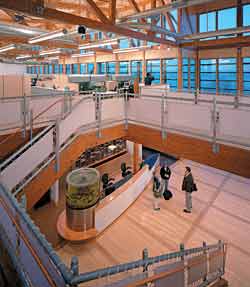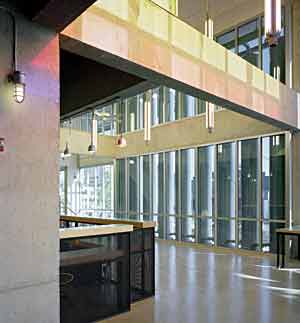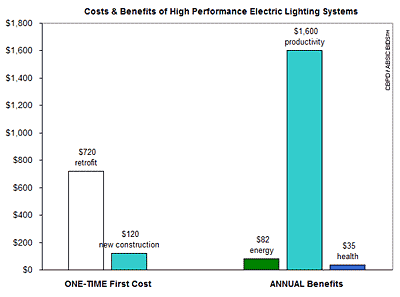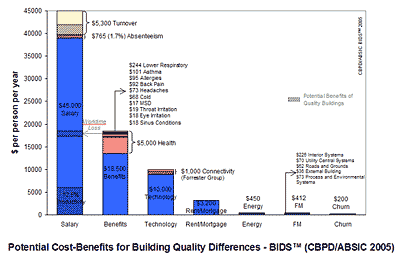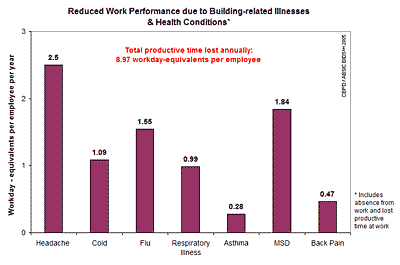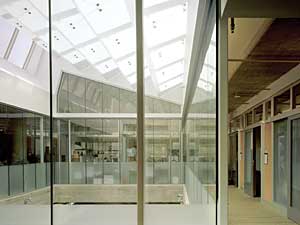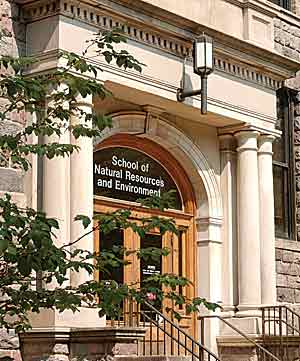The Green Market Reaches Critical Mass
A New Survey Finds a Growing Commitment to Green
![]() Continuing Education
Continuing Education
Use the following learning objectives to focus your study while reading this month’s Continuing Education article.
Learning Objectives - After reading this article, you will be able to:
- Have an increased understanding of the expanding green market and its different sectors.
- Find sources of research findings on building energy conservation, productivity and efficiency.
- Appreciate the importance of informed selection and specification of green products and materials.
As green building grows, so green products multiply. Since the PNC Financial Services' Firstside Center in Pittsburgh became the first U.S. Green Building Council's (USGBC) Leadership in Energy and Environment (LEEDâ„¢ ) certified building in 2000, projects have ranged from the Phillip Merrill Environmental Center, Chesapeake Bay Foundation, by the SmithGroup to New York's Coney Island's recently renovated Stillwell Avenue subway station in Brooklyn, a solar-powered train terminal. In five years, 285 projects have been LEED certified and 2,164 buildings registered.
But, as one architect remarked recently, "green isn't what it used to be when people thought it meant only solar panels."
Whole companies are even going green. One large construction company, for example, has made a corporate-wide commitment to green building. Aside from greening its construction practices and building internal expertise, it is also sponsoring a series of green building meetings promoting sustainable design and construction in education.
|
||||||||||||||
The American Institute of Architects' national and state chapters have green agendas and project awards programs. The AIA Committee on the Environment (COTE) recognizes projects that address issues such as energy and water conservation and sustainable or renewable products and construction materials.
The Eastern Sierra Residence in Gardnerville, NV, by Arkin Tilt Architects, one of the 2005 COTE Green Project winners, for example, contains structural insulated panels insulated concrete forms and Forest Stewardship Council (FSC)-certified wood.
This year the AIA launched its Sustainable Design Assessment Teams (SDAT) community assistance program, which brings a team of volunteer professionals to work with community decision-makers and stakeholders to help them develop a vision and framework for a sustainable future. In October 2005, AIA board member and charter president of GreeningUSA Peter J. Arsenault, AIA, NCARB, LEED-AP, Principal, Peter J. Arsenault, Architect, who led a SDAT team in Northampton, MA, reports that the team examined a range of issues, including energy use and efficiency. He also notes that private developers of small and large projects see the benefits of green building because of the increase in value and the philosophy of providing a better product.
Surveying the AEC community
Clearly, the market for green products is expanding and the implications for architects and specifiers intriguing and significant. But is green still a fad as some believe? Does green really cost more? Do manufacturers mostly view green as a customer "value-add" rather than as a strategic planning factor? Where are the reliable sources for green information? Throughout the 15-year history of the green building movement, architects, engineers, owners, and building product manufacturers have argued these and many other crucial questions, and with the prospects of a potentially broader market, they will continue to provoke debate.
For the first time, the AEC community supplies some answers in a new report released this month titledGreen Building SmartMarket Report 2006*.
Researched by McGraw-Hill Construction's Research and Analytics with support from the USGBC, the report analyzes the green design and construction marketplace.
|
||||||||||||||
It includes an overview of the green building movement, analysis of recently collected data from all sectors of the AEC, and interviews with leading building product manufacturers, federal agencies, and key green building innovators.
The survey, not only provides information on market trends, outlook, and economic impact, it analyses the perceptions of all players in the industry and what triggers green building. It also provides documentation that green building is no longer a fad and sole province of the environmentally aware, but an established, emerging market with a critical mass, significant economic and societal impact, and many opportunities for smart players.
SmartMarket found significant engagement in green building on the part of the AEC community: 40 percent of a representative sample of architects, engineers, contractors, and building owners are more than moderately involved in green building. Even more are actively involved: 60 percent of architects, engineers, and contractors are specifying and installing green products.
SmartMarket projects that between five and ten percent of new construction starts (non-residential) will be green projects by 2010. In 2000, the green marketplace was only a fraction of a percentage.
In 2004, green building comprised approximately 2 percent of the U.S. nonresidential market, which translates into approximately $3.3 billion. McGraw-Hill Construction forecasts U.S. non-residential construction starts will be worth approximately $204.5 billion in 2010. A projected growth of five to ten percent would mean between $10.2 billion and $20.5 billion in five years. On average, survey respondents expected the impact of green building on return on investment (ROI) to improve 6.6 percent.
How green is green?
Genuinely green products and materials are critical to successful green building and require long-term commitments to produce.
Yet overall, asSmartMarket found, large building product manufacturers, who are the tipping point to broad diffusion of green building, take a conservative or measured position on green building, most likely due to a typical three-year product planning cycle. Green products or features are seen as "value-adds" to meet customer requests, rather than as high importance to their business planning or strategy. Industry leaders also expressed concerns about "greenwashing," the term used to describe unfounded claims by manufacturers that their products are environmentally preferable or beneficial compared with alternatives.
One manufacturer believes that there is a problem with the current "green" thinking-"green" should not be thought of as products in isolation but instead as a "system" in which all the pieces need to work together. Another reported being concerned early on in the movement that fly-by-night manufacturers whose products would not live up to long-term scrutiny would undermine the entire green movement and corrupt the green market. He now thinks that manufacturers have been reasonably responsible due to the LEED standards. Industry leaders do agree on one point-no green leader has emerged.
Producers already offering a line of green products are taking green to another level such as, for example, manufacturing wood fiber particleboard with no added urea-formaldehyde. Regarding such a product, says Ray Barbee, Vice President, Sales and Marketing for Roseburg Forest Products which owns 750,000 acres of timberland, of which approximately 40 percent is FSC certified, third party tests verify formaldehyde emissions to be similar to those occurring naturally in outdoor ambient conditions.
|
||||||||||||||
Green systems gaining growth
In contrast, green lighting controls and water conservation systems are growing fast. "Sensors have been around since the early 70s, but there wasn't a lot of momentum for using them because of the low cost of energy. Sustainability design and LEED has changed the ballgame, even in the past two to three years." says Paul Trively, Vice President of Specification Sales for Lutron. "I've been in this business 37 years and sustainability is the biggest thing I've seen." With lighting contributing 70-80 percent to a building's energy costs, owners and employers are now acquiring automatic lighting controls, which control daylight in different parts of a space, and shading that reduces solar load. Because employees are the greatest expense, they are also paying attention to productivity and giving their people more controls, he observes, especially in healthcare where the shortage in nursing staff is forcing employers to provide patients with more lighting and shade controls. It's important for design professionals and building owners to discuss and quantify the costs of aesthetics, security, life safety, configurable office space, and other lighting needs, notes Trively.
Buildings with innovative water conservation systems range from Vermont state rebuilt rest stop by Timothy D. Smith & Associates, near Sharon, Vermont, which recycles wastewater through a greenhouse, to the 2005 COTE winner Austin Resource Center for the Homeless, Austin, TX, by LZT Architects, Inc., which has a 13,000-gallon rainwater collection system that supplements the building's water supply. "The industry is seeing a fast growing demand for water conservation products," says Jim Allen, Water Conservation Manager at Sloan Valve.
Not all manufacturers are taking a measured approach to green. Employee-owned Columbia Forest Products, North America's largest manufacturer of hardwood plywood and hardwood veneer, has certified its woods with the FSC for a number of years. So rather than dedicate a portion of its production facilities to formaldehyde-free products, it has begun converting all three of its veneer-core hardwood plywood plants to formaldehyde-free manufacturing processes using a patented soy-based adhesive. Next year it will convert three more plants. It's important to provide a cost-competitive solution while increasing moisture resistance without urea formaldehyde, says Columbia executive vice president of sales and marketing Ed Woods, who points out that urea formaldehyde is classified by the International Agency for Research on Cancer, part of the World Health Organization, as "carcinogenic to humans."
Deciding what is green
Determining what is truly green can be relatively straightforward. "We've been using American hardwoods for centuries," says Susan Regan of the Hardwood Council, "and in contrast to some of the exotics and synthetics, there's no problem with hardwood toxicity, sustainability, or local availability. And durability is certainly a given with wood products' life cycles that span generations."
Other products are far more complex. Take vinyl or polyvinyl chloride for instance, used in siding, drain/waste/vent pipes, flooring, and windows. In 2000, during the process of developing LEED's Commercial Interiors rating system, credit was proposed for the avoidance of PVC materials. In December 2004, a USGBC task force released its draft report which found the "evidence does not support a conclusion that PVC is consistently worse than alternative materials on a life cycle environmental and health basis," and recommended against a credit for excluding vinyl in the LEED rating system. The USGBC Task Force is still reviewing comments from experts in different disciplines and will be releasing a final report.
|
||||||||||||||
Allen Blakey, Director of Public Affairs at The Vinyl Institute points out that vinyl is highly durable and has many benefits-vinyl windows are thermally effective and vinyl-roofing membranes reflect heat.
Knowing the benefits of products is only part of the challenge of green design. Key to the design of any building is mastery of the specification process that earning a Construction Specification Institute (CSI) certificate provides. When applying for LEED certification, it is especially critical to avoid the risk of failing to attain certification due to a technical error. "Unique skills are necessary to develop the technical documents that permit the seamless integration of LEED's specific requirements into a project," says former CSI president Ross Spiegel, FCSI, CCS, CCCA, AIA, LEED-AP and CSI Liaison to the U.S. Green Building Council. "Whether it is the requirements for a construction waste management plan or low VOC content for paints, coatings or adhesives, the CSI Certified professional intuitively knows how and where these requirements fit into the contract documents.
In addition, they are well-suited to orchestrate the process necessary to submit for LEED Certification at the completion of the project's construction."
Does green really cost more?
SmartMarket points out that the USGBC and AIA are not the only groups involved in promoting green building efforts, though they enjoy the highest market penetration and public profile in relation to commercial green building. Other groups include the Sustainable Buildings Industry Council, Green Building Initiative, National Association of Home Builders, Southface Energy Institute, Energy & Environmental Building Association, New Buildings Institute, Inc. as well as a multitude of other groups.
|
||||||||||||||
It acknowledges that through these efforts, green building has remained at the forefront of the construction industry and has gained momentum to change construction practices.
More than half the architects surveyed expressed a strong preference for an independent third party to provide green building information and for a green products standard. At present there are a number of bodies, including manufacturer associations, which offer green certifications. One of the newest that will garner considerable respect is McDonough Braungart Design Chemistry (MBDC)'s Cradle to Cradle Certification, which recently announced the first products to qualify under rigorous examination that met stringent environmental and human health standards.
|
||||||||||||||
One of the salient issues covered in the survey concerns perceptions regarding the costs of green, which are not supported by research.SmartMarket found that all sectors of the AEC community cited higher first costs as the paramount obstacle to green building. Yet nearly all literature, from organizations ranging from the USGBC to the U.S. Department of Energy's Building Technology Program, highlights the cost-effectiveness of green building. Most literature suggests green building can be achieved for comparable costs to standard construction, with better up-front planning and/or energy or other cost savings as a result of green construction.(See sidebar for lists of research groups and research papers)
|
||||||||||||||
Productivity gains, though far more difficult to quantify than energy savings, have substantially larger payback potential and may be the key to more widespread adoption of green building. Though energy expenditures are the largest operating expense, the Building Owners and Managers Association (BOMA) and the Electric Power Research Institute state that office workers' salaries are 83.4 percent of total annual commercial expenditure whereas energy, electricity and repair and maintenance together amount to only 3 percent. But despite the need for research on productivity, the report states, payback data is scarce with few major studies quantifying green building performance. Among those who are actively studying productivity are the Carnegie Mellon University Center for Building Performance and Diagnostics and the University of California, Berkeley Center for the Built Environment.
The Carnegie Center's ongoing research project named e-Bids links productivity, health, and environmental cost-benefit case studies with key design guidelines for high-performance buildings. Its web-based tool (http://cbpd.arc.cmu.edu/ebids) illustrates the power of the arguments to date for daylighting, high performance electric lighting, mixed mode HVAC, commissioning, underfloor air, and cool roofs. Building Investment Decision Support (BIDSTM) (www.aia.org/cote_highlight) is a description of the BIDS (Building Investment Decision Support) tool and research project, funded by a consortium of industries and federal agencies dedicated to the performance of advanced building systems (ABSIC) (http://cbpd.arc.cmu.edu/bidstrial/). It is a rare and useful source of design guidelines and research findings. (see Figures 2 and 3)
Senior researcher Vivian Loftness, FAIA, Professor, School of Architecture Carnegie Mellon University, finds that building performance and productivity is best argued piece by piece. When faced with an audience of executives, she asks about the differences between a $10,000 car and a luxury model costing $30,000. Within moments she has sheets filled with answers. But when asked about superior buildings, people are hard put to come up with three features-and those are often gold plated fixtures and marble lobbies. Building quality, she maintains, can only be explained by breaking down the components.
Reducing energy and environmental costs
SmartMarket reports that by far the top-ranked business reason for involvement in green buildings is "lower operating costs." Commercial office buildings are often used as a prime example of potential savings. Annual energy costs of approximately $24 billion represents the single largest controllable expense. By reducing energy consumption by 30 percent through improved building operating standards-a goal readily achievable according to BOMA-7.2 billion could be saved each year. (See Figure 1)
|
||||||||||||||
The School of Nursing and Student Community Center at the University of Texas Health Science Center in Houston (anticipated to be a Gold LEED certified facility) by BNIM Architects, in collaboration with Lake Flato Architects completed in 2004, more than proved both BOMA's claim regarding energy savings and, at $212 per sq ft, that initial costs for building green are not prohibitive. Its energy consumption reduction achieved for LEED was 40 percent, which, at 2004 energy prices, will save the building approximately $38,000 annually. The building stores 826,000 gallons of grey water for toilet flushing and irrigation and uses an underfloor air-distribution system used in teaching and office spaces to save energy and increase occupant comfort. Materials and products specified included a 48 percent fly-ash cement mixture that prevented 1,808 tons of carbon dioxide from being released, cotton insulation, agrifiber board, and low Volatile Organic Compounds (VOC) paints, adhesives and sealants. The actual cost of the 194,000 gross sq ft building was $41,250,000.
|
||||||||||||||
Another Gold LEED project is the University of Michigan's Samuel T. Dana Building by William McDonough + Partners and the local architecture firm of Quinn Evans Architects in the School of Natural Resources and Environment. The $17.7 million renovation resulted in a 31 percent reduction in water use through installation of low-flow plumbing fixtures, composting toilets, and waterless urinals; 30 percent reduction in energy use through installation of high-efficiency lighting, and one of the first installations of ceiling-mounted radiant cooling system in the U.S. Additionally, it includes rubber flooring made from recycled rubber, ceiling panels made from biocomposites, bathroom tiles made from recycled glass, and toilet partitions made from recycled plastic bottles.
Where is the green growth?
The sectors with the most growth potential according to product manufacturers,SmartMarket reports, are government, education, and healthcare, in that order.
The education sector has a green building foothold, with 14 percent of registered LEED projects as of 2005. Student performance and health have been drivers toward much of the initial research on green building productivity improvements. The first major piece of legislation that included a provision for green building was in the education sector in the "Healthy, High-Performance Schools" section of the No Child Left Behind Act of 2001. This section would provide funds to local educational agencies via state educational agencies to "plan and prepare for healthy, high-performance school building projects" that reduce energy usage, "meet federal and state health and safety codes," and "support healthful, energy efficient and environmentally source practices." If funded fully, there will be increased monies spent on K-12 education green construction projects.
The federal government is already a major green player and had a role in the initial launch of LEED guidelines by providing a grant in its development stages. Forty four percent of LEED registered projects are federal, state, and local government owned.
Another boost to green growth is through government enticements at the regional and local level. To date, 14 states and 42 localities have adopted various mandates, gubernatorial orders, incentives and other mechanisms to encourage green building for both residential and non-residential projects. Other tax credits could be forthcoming from the 2005 Energy Bill when details are worked out.
While the subject of innovative healthcare design research has had nearly two decades of serious attention from the Center for Health Design and the National Symposium on Healthcare Design, to date there has not been significant green building involvement from the healthcare community. Only 30 projects have been registered for LEED certification. This reflects the AEC community's ranking of healthcare as the fifth largest potential growth market (manufacturers ranked it third). But interest may be on the rise. In October 2005, the AIA Academy of Architecture for Health (AAH) conference addressed "Realizing a Sustainable Architecture for Health."
The newly publishedGreen Guide for Health Care launched after a three-year development process should give further impetus to greening healthcare facilities. "It's a self-certification metric tool that allows the health care industry to measure its environmental performance in facilities construction and operation," explains co-coordinator Robin Guenther, AIA, Principal, Guenther 5 Architects. "It is the first such program that incorporates health-based criteria. We developed it in cooperation with the American Society for Health Care Engineering and the U.S. Green Building Council, using LEED as a basic framework. We had 4,500 registrants download the document and 20 facilities are now enrolled as pilot projects."
*The Green Building SmartMarket Report, created by McGraw-Hill Construction in partnership with the US Green Building Council, is available by calling (800) 591-4462.


